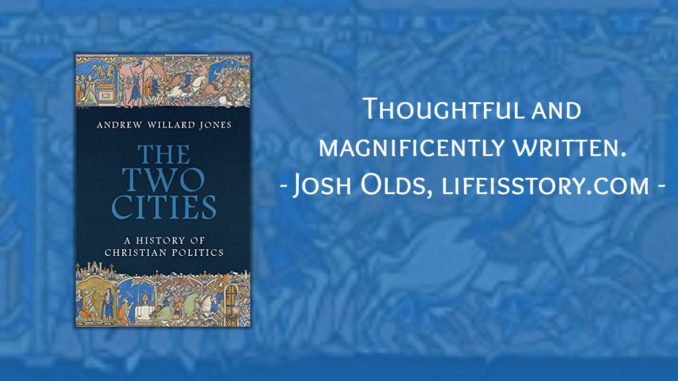
Published by Emmaus Road Publishing on June 28, 2021
Genres: Academic, Non-Fiction, Christian Life
Buy on Amazon
Goodreads

he prevailing narrative of human history, given to us as children and reinforced constantly through our culture, is the plot of progress. As the narrative goes, we progressed from tyranny to freedom, from superstition to science, from poverty to wealth, from darkness to enlightenment. This is modernity's origin myth. Out of it, a consensus has emerged: part of human progress is the overcoming of religion, in particular Christianity, and that the world itself is fundamentally secular.
In The Two Cities: A History of Christian Politics, Andrew Willard Jones rewrites the political history of the West with a new plot, a plot in which Christianity is true, in which human history is Church history.
The Two Cities moves through the rise and fall of empires; cycles of corruption and reform; the rise and fall of Christendom; the emergence of new political forms, such as the modern state, and new political ideologies, such as liberalism and socialism; through the horrible destruction of modern warfare; and on to the plight of contemporary Christians. These movements of history are all considered in light of their orientation toward or away from God.
The Two Cities advances a theory of Christian politics that is both an explanation of secular politics and a proposal for Christians seeking to navigate today's most urgent political questions.
The Two Cities is two thousand years of political history packed into just under 400 pages. Taking its title from Augustine’s The City of God, where he posits that there are two cities: Rome, which symbolizes everything worldly, and Jerusalem (the city of heaven), which symbolizes the Christian community. The history of the church, writes Andrew Willard Jones, is the struggle of the individual between the two. Jones, writing through a Catholic lens, leads readers from the Roman Empire to the American empire in an attempt to understand the church’s influence on the state throughout history.
Jones begins his work with a section that’s rather philosophical, working his way through early history from creation to the fall of Rome. It’s this section that defines the church and defines the polis, or the state, and shows how the two were always meant to intertwine. That’s a difficult concept, given that much of modern political sensibilities rely on the separation of church and state. But what Jones has in mind is that the Adamic mandate to subdue the earth involves creating community, culture, infrastructure—it involves creates a polis. Politics and religion are intertwined because what individuals believe affects how they create and build their polis.
From here, Jones works his way chronologically through history, with section growing larger than the next as he approaches modernity: 30 pages devoted to the ancient church; 40 pages to the medieval church; 30 to the Reformation; then 100 for the modern church and 60 for the post-modern. In this, we can see that one of Jones’ primary objectives is not just the dispassionate retelling of history, but the construction of a narrative intended to illuminate and provide direction for today. As Jones puts it, The Two Cities is “a historical narrative that is Christian through and through…capable of understanding modernity from within the truth of Christianity.”
Jones writes magnificently and in compelling fashion, positioning the Church as not just part of history but infused at the center of history. I especially appreciated the section on medieval history, both because it’s an area I don’t know a lot about and an area in which the Catholic Church became very secular to the point of almost losing its religion completely. While Jones probably wouldn’t say it that bluntly, he fully admits that corruption and sin abounded. However, it also points to a faithful remnant through it all, highlighting the ever-present struggle between the two cities. Coming from a Protestant tradition that remains suspicious of Catholicism, a lot of this history was completely new to me. Although Jones is Catholic, writing to Catholics, published by a Catholic publisher, this Protestant pastor (who is no longer suspicious of Catholics) was able to follow the narrative clearly. It was also refreshing to see a study of the Reformation from a Catholic perspective and Jones is balanced and nuanced in his evaluation.
Overall, there’s a lot to work through in The Two Cities and even where I don’t fully agree with Jones’s theological or philosophical points, his irenic tone and clear narrative are helpful for understanding how he came to that position and what his reasoning is. It’s a text to be grappled with, particularly in what it means for the church moving forward.
